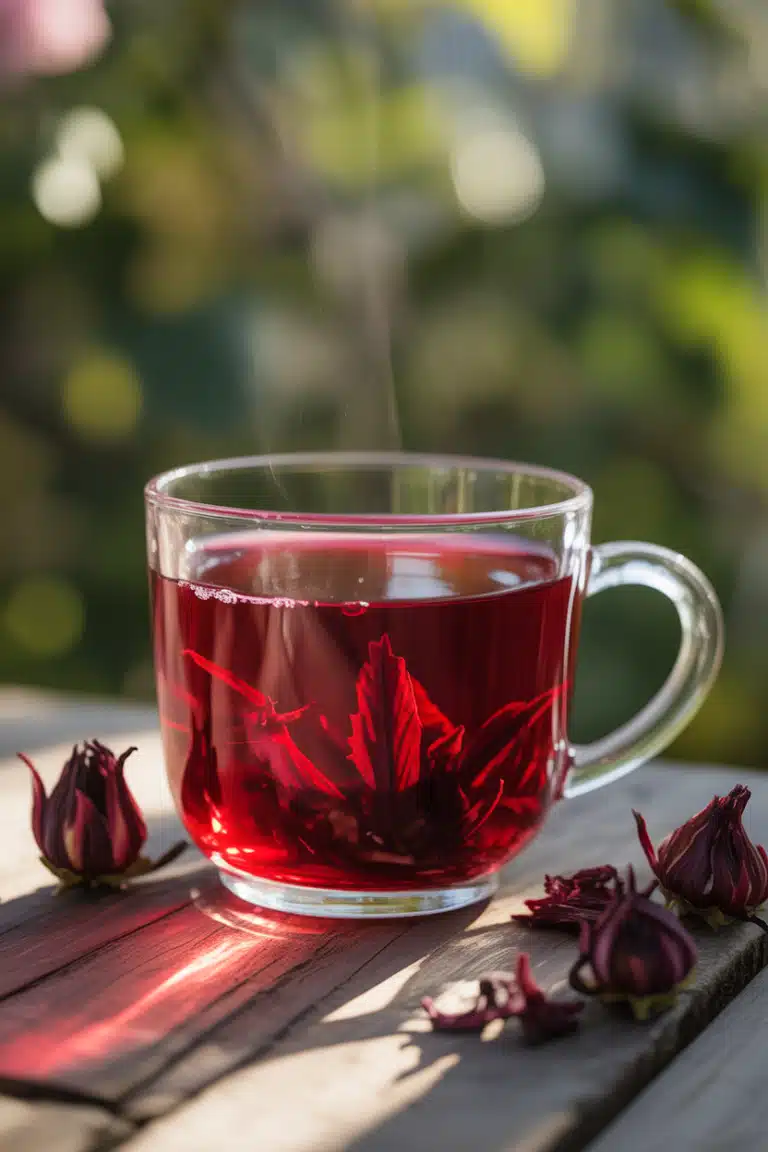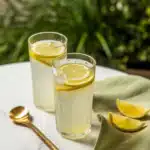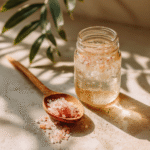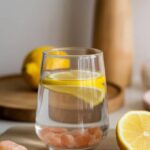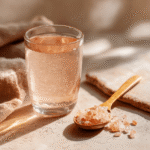Follow Me On Social Media!
Hibiscus Tea Recipe, and Side Effects: A Bold Brew with Purpose
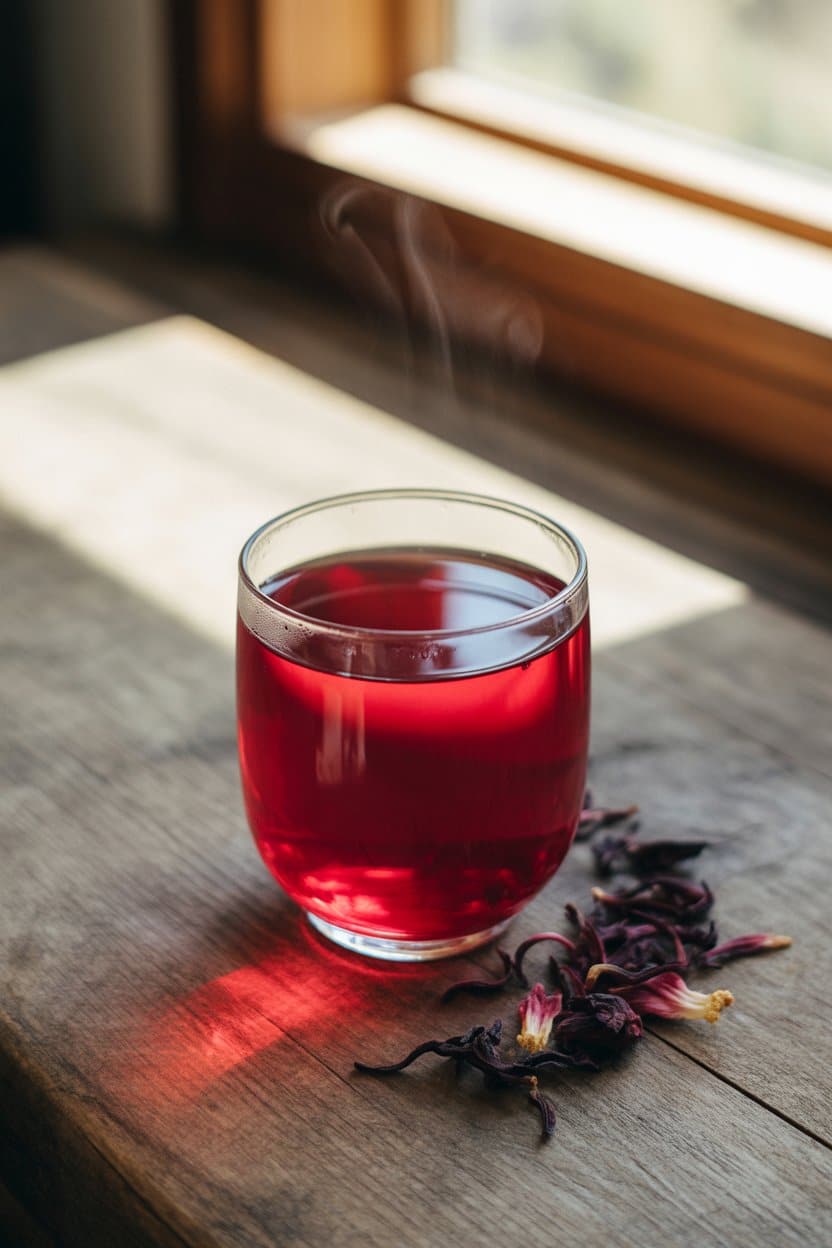
Hibiscus tea is more than just a vibrant red brew—it’s a centuries-old elixir with bold flavor and bold benefits. From ancient Egypt to modern wellness routines, this tart, floral tea has earned a reputation for lowering blood pressure, improving skin health, and supporting women’s wellness. In this article, we’ll walk through how to make hibiscus tea (dried or fresh), dive into its evidence-backed health benefits, and share its potential side effects. Whether you’re sipping it iced on a summer day or steeped warm for relaxation, hibiscus tea deserves a place in your cup—and your health routine.
Key Takeaways: What You Need To Know
- Hibiscus tea is made from the calyces (sepals) of the Hibiscus sabdariffa flower.
- It may help lower blood pressure and support heart and kidney health.
- It has antioxidants that benefit skin, metabolism, and women’s hormonal balance.
- You can brew it with dried petals or fresh hibiscus flowers.
- While safe for most, it may lower blood pressure too much or interact with medications.
- Egyptians traditionally drink it cold (“karkade”) as a symbol of hospitality and health.
Jump To :
Why I Fell in Love With Hibiscus Tea
What drew me to hibiscus tea?
It started with a sun-soaked afternoon in my kitchen. I was experimenting with bold botanical flavors when I stumbled upon a jar of dried hibiscus petals I’d forgotten about. The moment the hot water hit the petals, everything changed—the deep crimson bloom, the tangy aroma, the floral sourness that puckered the edges of my mouth. It was intense, playful, and wildly refreshing.
As someone who crafts mocktails for a living, I live for that spark—the flavor that wakes you up. Hibiscus tea delivered that and more.
It wasn’t long before I began infusing it into syrups, mixing it with mint or ginger, and even freezing it into summer pops. The more I learned, the more fascinated I became. This wasn’t just a pretty flower—it was hibiscus tea, and it came with a global history and science-backed health benefits I couldn’t ignore.
Is hibiscus tea more than just a pretty pink drink?
Absolutely. Hibiscus tea’s striking red hue comes from anthocyanins—the same compounds found in blueberries and red cabbage. These plant-based pigments don’t just look good; they fight oxidative stress and support cardiovascular health.
Across cultures—from West Africa to Mexico to Egypt—hibiscus has been brewed not just for refreshment but for healing, detoxification, and ritual. In the Caribbean, it’s the backbone of “sorrel” at Christmas. In Egypt, it’s served chilled to welcome guests. And in the U.S.? It’s finally getting the wellness spotlight it deserves.
If you’ve ever stood in the tea aisle, wondering if hibiscus tea is worth a try, let me just say: it’s not just tea—it’s tradition, flavor, and function in every sip.
Hibiscus Tea Benefits Backed by Science
What are the proven benefits of hibiscus tea?
Hibiscus tea benefits aren’t just passed down through tradition—they’re supported by modern science. This deep red herbal infusion is packed with antioxidants, polyphenols, and natural plant compounds like anthocyanins, which offer real advantages for heart, liver, and skin health.
One of the most compelling benefits is its ability to naturally lower blood pressure. In fact, a clinical study published in the Journal of Nutrition found that adults with mildly elevated blood pressure experienced measurable drops after drinking hibiscus tea daily for six weeks.
That kind of result puts hibiscus tea firmly in the category of functional wellness beverages—not just a flavorful herbal tea.
How does hibiscus tea help your body?
Here are the most researched benefits of drinking hibiscus tea regularly:
Lowers Blood Pressure
Hibiscus acts as a natural ACE inhibitor, helping blood vessels relax and improving circulation. This makes it a promising option for people managing hypertension without medication.
Supports Liver Health
Some animal and preliminary human studies show that hibiscus may help reduce liver fat accumulation and support liver enzyme function, improving detoxification pathways.
Fights Inflammation and Oxidative Stress
The antioxidants in hibiscus tea work to protect cells from free radicals, which contribute to aging and disease. This supports immune function and long-term health.
May Aid in Weight Management
A few small studies suggest that hibiscus extract could support weight loss by reducing the absorption of starches and lowering body fat percentages.
Improves Skin Appearance
Thanks to vitamin C and anti-inflammatory compounds, hibiscus tea may help with collagen production, reduce redness, and promote a clearer complexion over time.
Supports Hormonal Balance in Women
Some women report relief from PMS symptoms and menopausal discomfort after drinking hibiscus tea regularly. While studies are still limited, its mild phytoestrogenic effects may be beneficial.
How does hibiscus tea compare to other herbal teas?
Compared to popular herbal teas like chamomile or mint, hibiscus tea stands out for its physiological effects. While chamomile soothes and peppermint aids digestion, hibiscus is one of the few herbal teas with measurable cardiovascular and metabolic benefits. It also contains more antioxidants than black or green tea in some analyses, yet it’s caffeine-free and easy to blend.
Medical institutions, including the Mayo Clinic, have begun to acknowledge hibiscus tea as a complementary option for managing high blood pressure and improving overall heart health. That recognition has helped move hibiscus from niche herbalism into mainstream wellness.
It’s not just the flavor that makes hibiscus tea special. It’s the fact that every sip may be supporting your heart, your skin, and your body from the inside out.
How to Make Hibiscus Tea from Dried or Fresh Flowers
How do you make hibiscus tea at home?
Making hibiscus tea is simple, but the way you brew it can influence its taste, color, and health benefits. You can use either dried hibiscus petals—commonly sold as “hibiscus sabdariffa” or “roselle”—or fresh hibiscus calyces if you grow the plant yourself.
Hibiscus tea can be served hot or iced, sweetened or unsweetened, and even infused with ingredients like ginger, mint, or citrus. The tart flavor naturally balances out with honey or agave, though many enjoy it plain for its vibrant sour note.
Here’s how I make it in my kitchen.
Hibiscus Tea Recipe (Dried Petal Method)
Ingredients:
- 2 tablespoons dried hibiscus petals
- 2 cups water
- Optional: honey, cinnamon stick, fresh ginger, orange peel
Instructions:
- Bring the water to a boil.
- Add the dried hibiscus petals and any optional spices or aromatics.
- Remove from heat, cover, and steep for 10–15 minutes.
- Strain and sweeten to taste, if desired.
- Serve hot or chill and pour over ice.
This yields a rich, ruby-red tea with a sour, cranberry-like flavor. For a stronger brew, increase the steeping time or use more petals.
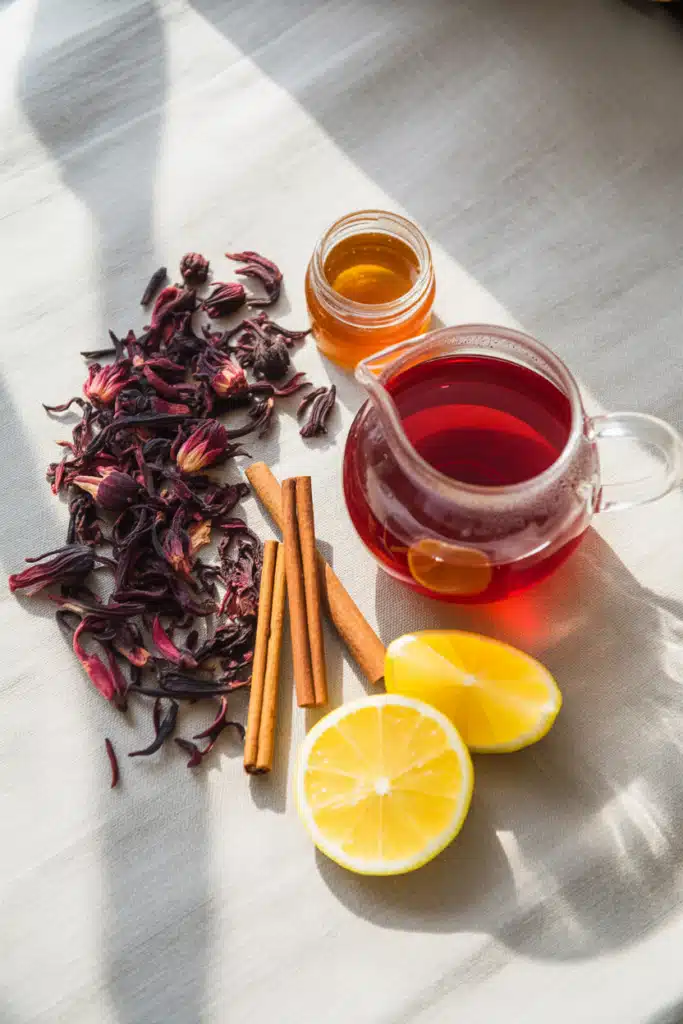
How to make hibiscus tea from fresh flowers
If you’re lucky enough to have access to fresh hibiscus flowers, follow this version:
Ingredients:
- 5–6 fresh hibiscus calyces (sepals), cleaned and trimmed
- 2 cups water
- Optional: honey, lime juice, or herbs
Instructions:
- Rinse the fresh calyces thoroughly to remove any dirt or bugs.
- Bring water to a boil and add the hibiscus.
- Simmer gently for 10 minutes.
- Strain and adjust flavor with lime or sweetener if desired.
Fresh hibiscus tea has a slightly brighter and more floral taste than the dried version. You can refrigerate leftovers for up to 3 days.
How long should you steep hibiscus tea?
Steeping for at least 10 minutes extracts the full range of flavor and antioxidants. If you’re brewing it for health benefits—especially blood pressure support—you’ll want to let it sit covered during steeping to preserve volatile compounds.
Avoid over-steeping beyond 20 minutes, which can bring out an overly astringent taste.
Where can you buy dried hibiscus petals?
You can find dried hibiscus petals at health food stores, tea shops, international markets, and online retailers. Look for organic petals without added oils or flavoring. A good-quality dried hibiscus will appear deep burgundy in color and smell tangy, almost like dried cranberries.
For those new to hibiscus, the USDA provides additional information on how hibiscus plants are harvested and dried, particularly in tropical regions. Here’s a reliable source for understanding the agricultural side of hibiscus:
This USDA resource discusses the medicinal, culinary, and nutritional uses of hibiscus and is a helpful reference for anyone considering growing it or learning more about its properties.
Hibiscus Tea Side Effects and Real Experiences
What are the side effects of hibiscus tea?
While hibiscus tea offers many benefits, it’s important to recognize its potential side effects—especially for people with specific health conditions or those taking medications. Just because it’s natural doesn’t mean it’s risk-free.
Here are the most commonly reported side effects:
May lower blood pressure too much
Hibiscus tea has a natural blood pressure-lowering effect. If you’re already taking antihypertensive medication, combining the two could cause hypotension or dizziness.
Can affect kidney function in high doses
There’s some evidence that drinking very large quantities of hibiscus tea daily may affect kidney function. However, normal consumption (1–2 cups per day) is generally considered safe.
May interact with medications
Hibiscus may interfere with medications such as acetaminophen, hydrochlorothiazide, and some antibiotics. If you’re on prescription drugs, talk to your healthcare provider before adding hibiscus to your routine.
Hormonal influence
Some animal studies suggest that hibiscus may have mild estrogenic effects. This could be beneficial for menopausal symptoms but might not be suitable for individuals with hormone-sensitive conditions.
Pregnancy and fertility caution
Hibiscus tea is sometimes avoided during early pregnancy due to concerns it may stimulate uterine contractions. Though evidence is limited, it’s best to consult your OB-GYN before using hibiscus during pregnancy or while trying to conceive.
What does the science say about hibiscus tea and kidney health?
Research on hibiscus tea and kidney function is still developing. Some studies suggest antioxidant benefits for kidney tissue, while others advise caution with excessive daily use. As with most herbs, dosage matters.
For people with chronic kidney disease, the oxalate content in hibiscus may raise concerns. If you’re on a renal diet, consult your doctor or a registered dietitian before consuming hibiscus regularly.
Real-life testimonial: What happened when I drank hibiscus tea every day
I asked one of my readers, Mia—a certified yoga instructor from Austin, TX—about her experience with hibiscus tea. Here’s what she shared:
“I started drinking iced hibiscus tea daily during the summer. Within a week, I noticed I wasn’t getting my usual afternoon headache. My blood pressure is slightly elevated, and my doctor said the tea could be helping. I felt more hydrated and less bloated too. But after about three weeks, I started feeling a bit light-headed, especially when standing up too fast. I scaled back to a few times a week, and now it’s perfect for me.”
Mia’s experience highlights the importance of listening to your body and adjusting your intake if needed.
Hibiscus Tea and Women’s Health
How does hibiscus tea support hormonal balance in women?
Hibiscus tea has been used in traditional medicine to support women’s health for generations. While more research is needed, early findings and anecdotal evidence suggest it may offer benefits for PMS symptoms, menopause relief, and mild hormonal balance.
Hibiscus contains plant-based compounds that appear to have phytoestrogenic effects—meaning they may mimic or support estrogen activity in the body in a very mild way. This can be especially helpful during times when hormone levels fluctuate, such as:
- The luteal phase of the menstrual cycle (just before your period)
- Perimenopause, when estrogen levels start dropping
- Post-menopause, when natural estrogen is very low
Many women find that hibiscus tea helps reduce water retention, soothe cramps, and support overall mood during these hormonal shifts.
Can hibiscus tea ease symptoms of PMS or menopause?
Here’s what current use and small-scale studies suggest:
For PMS:
Some women report reduced bloating, breast tenderness, and irritability after drinking this herbal infusion in the days leading up to their period. Its anti-inflammatory and diuretic properties may be partly responsible.
For menopause:
Hot flashes, mood swings, and sleep disturbances may be eased with herbal teas, including hibiscus. While it doesn’t contain strong phytohormones, its cooling, hydrating properties and support for blood pressure regulation make it a gentle daily ritual during midlife transitions.
For energy and metabolism:
Fatigue and slowed metabolism can accompany hormonal shifts. Hibiscus tea’s antioxidant content and potential metabolism-boosting effects may offer subtle support, especially when combined with good nutrition and movement.
How can women incorporate hibiscus tea into daily life?
If you’re considering adding floral drink to your wellness routine, here are a few simple ideas:
- Drink 1 cup in the morning during your menstrual cycle to help with bloating.
- Sip iced hibiscus with mint in the afternoon to cool hot flashes.
- Use hibiscus concentrate in a sparkling water spritz for an uplifting mocktail during a PMS slump.
- Combine hibiscus with raspberry leaf tea for added menstrual support.
Because it’s caffeine-free and easy on the stomach, hibiscus tea fits beautifully into a routine focused on self-care, hydration, and hormone harmony.
Skin, Kidneys, and Blood Pressure – The Deeper Benefits of Hibiscus Tea
Does hibiscus tea improve skin health?
Hibiscus tea is often called “nature’s Botox” in herbal beauty circles—and for good reason. Its natural content of vitamin C, antioxidants, and anti-inflammatory compounds can support clearer, firmer, more radiant skin from within.
Here’s how it works:
Promotes collagen production
Vitamin C is essential for collagen synthesis. this crimson beverage provides a gentle, bioavailable form that helps maintain skin elasticity and reduce the appearance of fine lines.
Fights oxidative stress
Antioxidants like anthocyanins in hibiscus fight free radicals, which contribute to premature aging, dullness, and uneven skin tone.
Reduces redness and inflammation
If you struggle with acne, rosacea, or hormonal breakouts, hibiscus tea’s anti-inflammatory properties may help reduce flare-ups and calm the skin.
Drinking hibiscus tea regularly, especially when paired with a high-antioxidant diet, can support a visibly healthier complexion over time.
What effect does hibiscus tea have on the kidneys?
This is one of the more debated areas of hibiscus tea research. Some small studies suggest hibiscus supports kidney health by reducing oxidative damage and helping the body flush out waste. It acts as a natural diuretic, which may benefit those prone to water retention or mild kidney stress.
However, hibiscus tea is also moderately high in oxalates—compounds that can contribute to kidney stones in susceptible individuals. If you have a history of kidney stones or chronic kidney disease, it’s best to consult a doctor before adding hibiscus tea to your daily routine.
Moderation is key. For most healthy adults, 1–2 cups per day are well tolerated and may support detoxification and fluid balance.
Is hibiscus tea really effective for lowering blood pressure?
Yes—and this is one of the most studied benefits of caffeine-free tea . In clinical trials, individuals with mild to moderate hypertension saw significant reductions in both systolic and diastolic blood pressure after drinking hibiscus tea daily for a few weeks.
Here’s what researchers believe is happening:
- Hibiscus may inhibit ACE enzymes, which are involved in constricting blood vessels. This leads to more relaxed blood flow.
- Its anti-inflammatory and diuretic effects may reduce fluid buildup and pressure on the vascular system.
- The antioxidants in hibiscus may protect arteries from damage and improve overall circulation.
For people with borderline or mildly elevated blood pressure, hibiscus tea can be a helpful lifestyle addition. However, if you’re already on blood pressure medication, be sure to monitor levels and talk with your doctor, as combining the two can sometimes lower blood pressure too much.
Why Egyptians Drink Hibiscus Tea and 10 Medicinal Uses
Why is hibiscus tea popular in Egypt?
In Egypt, hibiscus tea—called karkadé—is much more than a drink. It’s tradition, medicine, and hospitality in a cup. Egyptians serve karkadé cold at weddings, family gatherings, and street-side cafés. Its deep red color symbolizes celebration, vitality, and heart.
Traditionally, karkadé is believed to cool the body, especially in the intense desert heat, and it’s long been used to soothe digestion, calm nerves, and balance fluids. Cold karkadé is often sweetened, while the hot version is sipped more slowly, often after meals.
Historical records show that hibiscus was used medicinally in Pharaonic Egypt, and it remains a part of modern herbal practices throughout North Africa and the Middle East.
What are 10 medicinal uses of hibiscus tea?
Here are ten ways hibiscus tea has been used across cultures and time periods—some backed by science, others passed through generations:
- Lowering blood pressure – Well-documented in clinical studies.
- Reducing cholesterol – May help lower LDL (“bad” cholesterol) and improve heart health.
- Supporting liver health – Protective against fatty liver buildup in early research.
- Boosting immunity – High in vitamin C and flavonoids.
- Reducing inflammation – Helpful for joint pain and chronic inflammation.
- Easing PMS symptoms – Supports mood, reduces cramps and water retention.
- Supporting metabolism – May aid fat breakdown and digestion.
- Improving skin clarity – Due to its antioxidant and anti-inflammatory effects.
- Helping with anxiety – Mild calming effect without drowsiness.
- Cooling the body – Traditionally used to reduce internal heat and dehydration.
These uses make hibiscus tea one of the few herbal infusions that offer both therapeutic benefit and cultural depth. It’s a rare blend of beauty, function, and story.
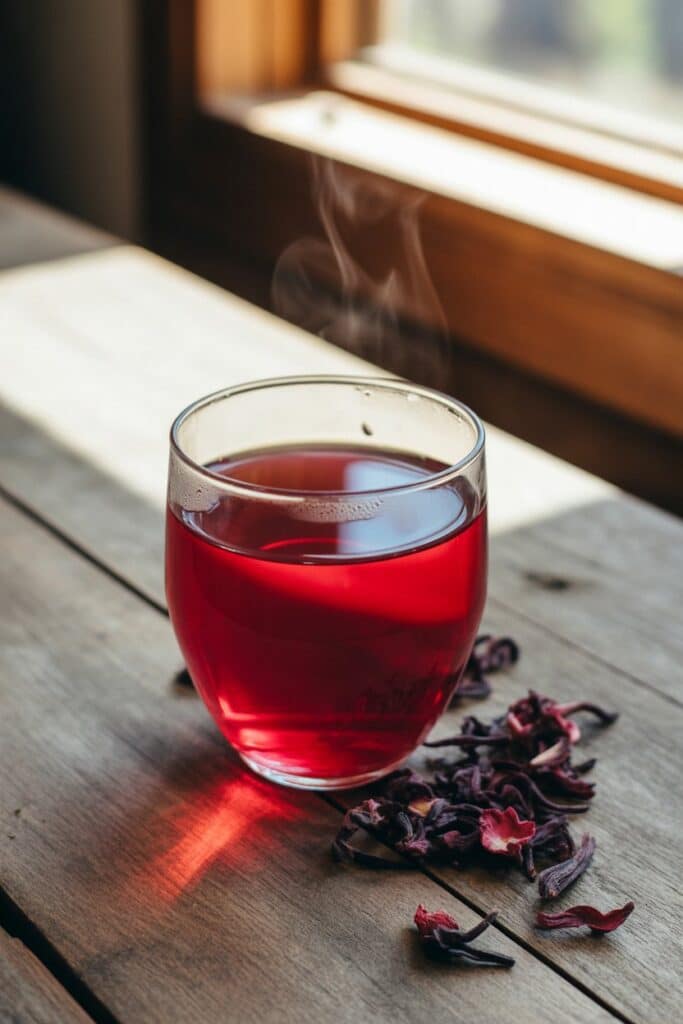

Hibiscus Tea
Ingredients
Equipment
Method
- Bring 2 cups of water to a boil in a saucepan.
- Add hibiscus petals and any optional herbs or spices. Remove from heat.
- Cover and steep for 10 minutes.
- Strain into teacups. Sweeten if desired. Serve hot or chilled.
Nutrition
Notes
Tried this recipe?
Let us know how it was!FAQ: Answering Common Questions About Hibiscus Tea
Can hibiscus plants be used to make tea?
Yes, but only Hibiscus sabdariffa (roselle) is used for tea. The calyces—not the petals—are harvested, dried, and steeped.
Does hibiscus tea lower blood pressure?
Yes. Clinical studies show that hibiscus tea can lower systolic and diastolic blood pressure in people with mild hypertension.
What are the side effects of drinking hibiscus tea?
Possible side effects include dizziness, lowered blood pressure, and interactions with medications. Avoid during early pregnancy or with kidney disease unless cleared by a doctor.
What is hibiscus tea good for?
Hibiscus tea is good for heart health, hydration, skin clarity, liver support, and managing mild inflammation or hormonal symptoms.
Why do Egyptians drink hibiscus tea?
It’s a cultural tradition for cooling, healing, and celebration. Served as “karkadé,” it’s considered a symbol of warmth and wellness.
What are 10 medicinal uses of hibiscus?
Lowering blood pressure, reducing cholesterol, aiding liver function, boosting immunity, soothing PMS, cooling the body, improving skin, and more—see the list above.
Conclusion
Hibiscus tea is one of those rare ingredients that bridges the gap between flavor, function, and tradition. It’s vibrant, powerful, and easy to enjoy, whether you’re sipping it hot on a cool evening or chilled under summer sun.
For centuries, people across the world—from Egyptian healers to modern herbalists—have turned to hibiscus not just for refreshment but for recovery, relief, and reconnection to nature’s rhythm.
So if you’ve ever overlooked this striking red tea, now’s the time to steep it with intention. Your body—and your tastebuds—might just thank you.


